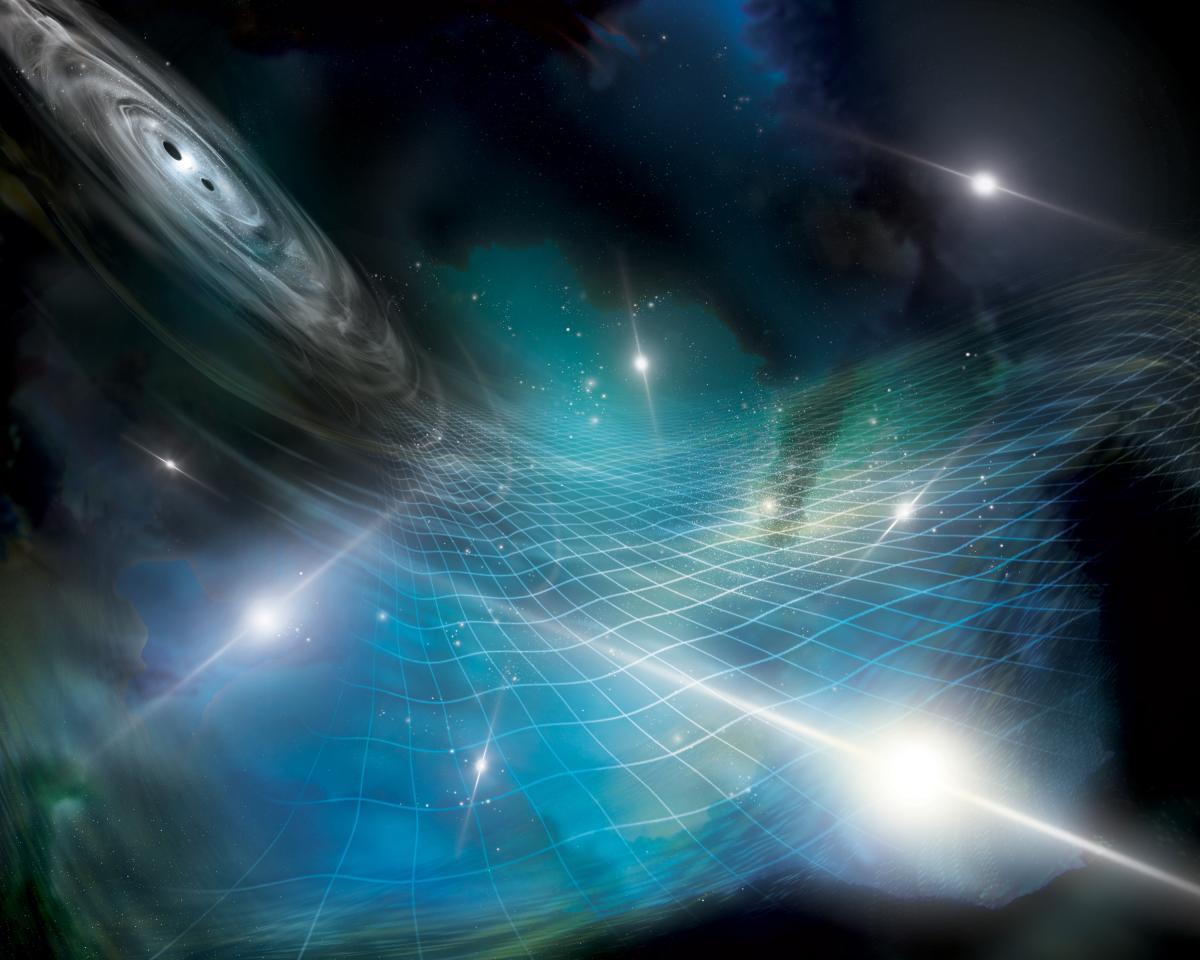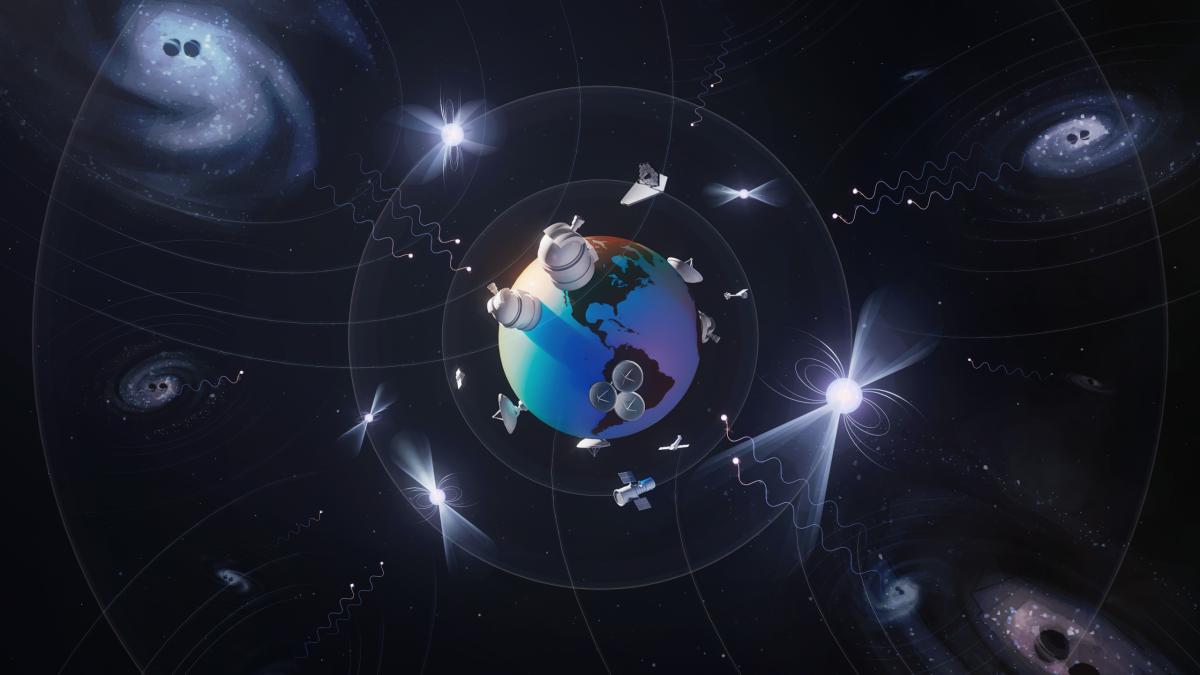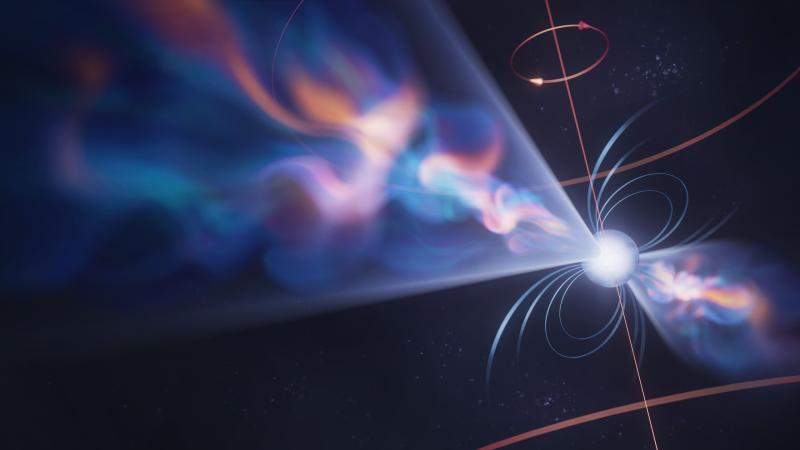
Artist’s interpretation of an array of pulsars being affected by gravitational ripples produced by a supermassive black hole binary in a distant galaxy. Credit: Aurore Simonnet for the NANOGrav Collaboration
Astrophysicists using large radio telescopes to observe a collection of cosmic clocks in our Galaxy have found evidence for gravitational waves that oscillate with periods of years to decades, according to a set of papers published today in The Astrophysical Journal Letters. The gravitational-wave signal was observed in 15 years of data acquired by the North American Nanohertz Observatory for Gravitational Waves (NANOGrav) Physics Frontiers Center (PFC), a collaboration of more than 190 scientists from the US and Canada who use pulsars to search for gravitational waves. International collaborations using telescopes in Europe, India, Australia and China have independently reported similar results.
While earlier results from NANOGrav uncovered an enigmatic timing signal common to all the pulsars they observed, it was too faint to reveal its origin. The 15-year data release demonstrates that the signal is consistent with slowly undulating gravitational waves passing through our Galaxy.
“This is key evidence for gravitational waves at very low frequencies,” says Vanderbilt University’s Dr. Stephen Taylor, who co-led the search and is the current Chair of the collaboration. “After years of work, NANOGrav is opening an entirely new window on the gravitational-wave universe."
Unlike the fleeting high-frequency gravitational waves seen by ground-based instruments like LIGO (the Laser Interferometer Gravitational-wave Observatory), this continuous low-frequency signal could be perceived only with a detector much larger than the Earth. To meet this need, astronomers turned our sector of the Milky Way Galaxy into a huge gravitational-wave antenna by making use of exotic stars called pulsars. NANOGrav’s 15-year effort collected data from 68 pulsars to form a type of detector called a pulsar timing array.
A pulsar is the ultra-dense remnant of a massive star's core following its demise in a supernova explosion. Pulsars spin rapidly, sweeping beams of radio waves through space so that they appear to “pulse” when seen from the Earth. The fastest of these objects, called millisecond pulsars, spin hundreds of times each second. Their pulses are very stable, making them useful as precise cosmic timepieces.
Over 15 years of observations with the Arecibo Observatory in Puerto Rico, the Green Bank Telescope in West Virginia, and the Very Large Array in New Mexico, NANOGrav has gradually expanded the number of pulsars they observe. “Pulsars are actually very faint radio sources, so we require thousands of hours a year on the world’s largest telescopes to carry out this experiment,” Dr. Maura McLaughlin of West Virginia University and co-Director of the NANOGrav PFC explains. “These results are made possible through the National Science Foundation’s (NSF’s) continued commitment to these exceptionally sensitive radio observatories.”
Einstein’s theory of general relativity predicts precisely how gravitational waves should affect pulsar signals. By stretching and squeezing the fabric of space, gravitational waves affect the timing of each pulse in a small but predictable way, delaying some while advancing others. These shifts are correlated for all pairs of pulsars in a way that depends on how far apart the two stars appear in the sky.
“The large number of pulsars used in the NANOGrav analysis has enabled us to see what we think are the first signs of the correlation pattern predicted by general relativity,” says Oregon State University’s Dr. Xavier Siemens, co-Director of the NANOGrav PFC.
Observing so many pulsars requires a huge investment in people, infrastructure, and time. In 2004, a small group of astronomers carried out the first set of pulsar observations that would form the foundation for this work. For nearly two decades, the group has been growing in the number of people and diversity of expertise needed to perform this complex gravitational-wave search. Along the way, the NANOGrav collaboration took form, using the members' combined knowledge and skills to expand the data collection and improve the analysis.
Initially, pulsar instrumentation was not precise enough to achieve the sensitivity needed for this experiment. The team worked to develop next-generation instrumentation for both the Arecibo and Green Bank telescopes. They scoured known pulsars to find those precise enough to enable the search for low-frequency gravitational waves and added them to the pulsar timing array. In parallel, there were advances in theory and breakthroughs in data-analysis techniques that are tuned and optimized for modern computing architectures.
Along the way, NANOGrav found many uses for their rich pulsar timing data, addressing a wide range of intriguing astrophysical puzzles. The data and NANOGrav's methodologies are described in companion papers. “This marks the first time we’ve released the software used to produce our data set alongside the data products themselves,” Dr. Joseph Swiggum of Lafayette College, who led the pulsar timing paper explains. “All the tools necessary to reproduce our results are now public, making it easier for other scientists to get involved. This will foster improvements to the code, grow our interactions with the community, and provide educational opportunities for students.”
In 2020, with just over twelve years of data, NANOGrav scientists began to see hints of a signal, an extra “hum” that was common to the timing behavior of all pulsars in the array, and that careful consideration of possible alternative explanations could not eliminate. The collaboration felt confident that this signal was real, and becoming easier to detect as more observations were included. But it was still too faint to show the gravitational-wave signature predicted by general relativity. Now, their 15 years of pulsar observations are showing the first evidence for the presence of gravitational waves, with periods of years to decades.
University of Wisconsin-Milwaukee’s Dr. Sarah Vigeland who, with Taylor, is spearheading NANOGrav’s effort to determine the source of the signal, says, “Now that we have evidence for gravitational waves, the next step is to use our observations to study the sources producing this hum. One possibility is that the signal is coming from pairs of supermassive black holes, with masses millions or billions of times the mass of our Sun. As these gigantic black holes orbit each other, they produce low-frequency gravitational waves.”
Supermassive black holes are believed to reside at the centers of the largest galaxies in the Universe. When two galaxies merge, the black holes from each wind up sinking to the center of the newly-combined galaxy, orbiting each other as a binary system long after the initial galaxy merger. Eventually, the two black holes will coalesce. In the meantime, their slow inspiral stretches and squeezes the fabric of space-time, generating gravitational waves that propagate away from their origin galaxy like ripples in a pond, eventually reaching our own.
Gravitational-wave signals from these gigantic binaries are expected to overlap, like voices in a crowd or instruments in an orchestra, producing an overall background “hum” that imprints a unique pattern in pulsar timing data. This pattern is what NANOGrav scientists have been seeking for almost 20 years. In its suite of newly published papers, NANOGrav demonstrates evidence for this gravitational-wave background.
Detailed analysis of the background hum is already providing insights into how supermassive black holes grow and merge. Given the strength of the signal NANOGrav sees, the population of extremely massive black hole binaries in the Universe must number in the hundreds of thousands, perhaps even millions.
“At one point, scientists were concerned that supermassive black holes in binaries would orbit each other forever, never coming close enough together to generate a signal like this,” says Dr. Luke Kelley, of University of California, Berkeley, and chair of NANOGrav’s astrophysics group. “But now we finally have strong evidence that many of these extremely massive and close binaries do exist. Once the two black holes get close enough to be seen by pulsar timing arrays, nothing can stop them from merging within just a few million years.”

The supermassive black hole binaries at the cores of galaxies produce electromagnetic waves at radio to gamma-ray wavelengths that can be detected by telescopes on Earth and in space. They also produce gravitational waves that can be studied through their effects on an array of radio pulsars. These dual electromagnetic and gravitational wave messengers provide extremely valuable insights that cannot be gleaned from either type of observation alone. Illustration: Olena Shmahalo
Future investigation of this signal will feed into scientists' understanding of how the Universe evolved on the largest scales, providing information about how often galaxies collide, and what drives black holes to merge. In addition, gravitational ripples of the Big Bang itself may make up some fraction of the signal, offering insight into how the Universe itself was formed. These results even have implications at the smallest scales, placing limits on what kind of exotic particles may exist in our Universe. "This is an important milestone in NSF's multifaceted effort to leverage gravitational wave signals to gain a clearer understanding of phenomena at the astrophysical frontier," says NSF's Physics Frontiers Centers Program Director Michael Cavagnero.
Over time, NANOGrav expects to be able to pick out the contributions of relatively nearby, individual supermassive black hole binaries. "We’re using a gravitational-wave detector the size of the galaxy that’s made out of exotic stars, which just blows my mind,” exclaims National Radio Astronomy Observatory’s Dr. Scott Ransom. “Our earlier data told us that we were hearing something, but we didn't know what. Now we know that it’s music coming from the gravitational universe. As we keep listening, we'll likely be able to pick out notes from the instruments playing in this cosmic orchestra. Combining these gravitational-wave results with studies of galaxy structure and evolution will revolutionize our understanding of the history of our Universe.”
Support from the National Science Foundation (NSF) has been critical to NANOGrav’s success by providing support for scientific work through the Physics Frontiers Center program and through access to multiple world-class radio telescopes. Future NANOGrav results will incorporate data from Canada’s CHIME telescope, added to the project in 2019.
"The NSF NANOGrav team created, in essence, a galaxy-wide detector revealing the gravitational waves that permeate our universe," says NSF Director Sethuraman Panchanathan. "The collaboration involving research institutions across the U.S. shows that world-class scientific innovation can, should and does reach every part of our nation.”
Astrophysicists around the globe have been busy chasing this gravitational-wave signal. Several papers released today by the Parkes Pulsar Timing Array in Australia, the Chinese Pulsar Timing Array, and the European Pulsar Timing Array/Indian Pulsar Timing Array report hints of the same signal in their data. Through the International Pulsar Timing Array consortium, regional collaborations are working together to combine their data in order to better characterize the signal and search for new types of sources. “Our combined data will be much more powerful,” says Taylor. “We’re excited to discover what secrets they will reveal about our Universe.”
The NANOGrav collaboration receives support from National Science Foundation Physics Frontiers Center award numbers 1430284 and 2020265, the Gordon and Betty Moore Foundation, NSF AccelNet award number 2114721, a Natural Sciences and Engineering Research Council of Canada (NSERC) Discovery Grant, and the Canadian Institute for Advanced Research (CIFAR). The Arecibo Observatory is a facility of the National Science Foundation operated under cooperative agreement (#AST-1744119) by the University of Central Florida (UCF) in alliance with Universidad Ana G. Méndez (UAGM) and Yang Enterprises (YEI), Inc. The Green Bank Observatory and The National Radio Astronomy Observatory are facilities of the National Science Foundation operated under cooperative agreements by Associated Universities, Inc.
Seminal Publications:
Focus on NANOGrav's 15 yr Data Set and the Gravitational Wave Background The Astrophysical Journal Letters.
- The NANOGrav 15-year Data Set: Observations and Timing of 68 Millisecond Pulsars. DOI: 10.3847/2041-8213/acda9a
- The NANOGrav 15-Year Data Set: Detector Characterization and Noise Budget. DOI: 10.3847/2041-8213/acda88
- The NANOGrav 15-year Data Set: Evidence for a Gravitational-Wave Background. DOI: 10.3847/2041-8213/acdac6
- The NANOGrav 15-year Data Set: Constraints on Supermassive Black Hole Binaries from the Gravitational Wave Background. DOI: 10.3847/2041-8213/acdc91
- The NANOGrav 15-year Data Set: Search for Signals from New Physics. DOI: 10.3847/2041-8213/acdc91
- The NANOGrav 15-year Data Set: Bayesian Limits on Gravitational Waves from Individual Supermassive Black Hole Binaries. DOI: arXiv:2306.16222
- The NANOGrav 15-year Data Set: Search for Anisotropy in the Gravitational-Wave Background. DOI: arXiv:2306.16221
Read more:
- New York Times. "The Cosmos Is Thrumming With Gravitational Waves, Astronomers Find."
- Washington Post. "In a major discovery, scientists say space-time churns like a choppy sea."
- National Public Radio (NPR). "Scientists have found signs of a new kind of gravitational wave. It's really big."
- Scientific American. "First Evidence of Giant Gravitational Waves Thrills Astronomers."
- Scientific American. "A Background ‘Hum’ Pervades the Universe. Scientists Are Racing to Find Its Source."
- Astrobites. "Drop the Bass: Evidence for a Gravitational Wave Background from a Galaxy-sized Detector."
- Bad Astronomy. "Breaking astronomy news: The background hum of the Universe is finally revealed!"
- Sky & Telescope. "Gravitational Waves From Supermassive Black Holes Revealed."
- CBS News. "For the first time ever, scientists 'hear' gravitational waves rippling through the universe."
- ABC News. "Scientists have finally 'heard' the chorus of gravitational waves that ripple through the universe."
- PBS. "PBS NewsHour for June 29th, 2023."
- The Guardian. "Astronomers detect 'cosmic bass note' of gravitational waves."
- BBC News. "Northern Ireland scientist's role in black hole shock-waves find."
- New Scientist. "Gravitational waves produce a background hum across the whole universe."
- The Globe and Mail. "Scientists report cosmic hum that may come from clusters of massive black holes."
- UK Today News. "Gravitational waves produce a background hum across the whole universe."
- BBC Science Focus. "Groundbreaking gravitational wave discovery could unlock our Universe's deepest mysteries."
- Popular Science. "Astronomers used dead stars to detect a new form of ripple in space-time."
- Reuters. "Scientists discover that universe is awash in gravitational waves."
- Wired. "At Last, There's Evidence of Low-Frequency Gravitational Waves."
- National Geographic. "Colossal gravitational waves -- trillions of miles long -- found for the first time."
- The Wall Street Journal. "Black Hole at the Heart of Our Galaxy Is on Crash Course, Space-Time Ripples Reveal."
- USA Today. "Scientists hear gravitational waves in space."
- Nature. "Monster gravitational waves spotted for the first time."
- CIFAR. "CIFAR members among team to find first evidence of low-frequency gravitational waves."
- Live Science. "The universe is rippling with a faint 'gravitational wave background' created by colliding black holes, huge international study suggests."
- Boston Globe. "The cosmos is thrumming with gravitational waves, astronomers find."
- NDTV. "Scientists Say Universe Has a 'Background Hum', It Sounds Like ..."
- APS Physics. "Researchers Capture Gravitational-Wave Background with Pulsar 'Antennae'."
- Washington Post. "Opinion | I’m a physicist. Last week’s gravitational waves announcement sent me reeling."
- Space.COM. "The gravitational wave background of the universe has been heard for the first time."
- Space.COM. "The universe is humming with gravitational waves. Here's why scientists are so excited about the discovery."
- Nature. "Giant gravitational waves: why scientists are so excited."
- The Atlantic. "Scientists Found Ripples in Space and Time. And You Have to Buy Groceries."
- Vice. "Scientists Glimpse Background 'Hum' of Spacetime in Major Breakthrough."
- Gizmodo. "Breathrough Gravitational Wave Findings Suggest Supermassive Black Holes Are Constantly Warping Spacetime."
- ARS Technica. "A Liquid Background Chours -- NANOGrav hears 'hum' of gravitational wave background, louder than expected."
- Physics World. "Pulsar timing irregularities reveal hidden gravitational-wave background."
- Phys.ORG. "Q&A: Astrophysicist discusses new evidence of gravitational waves."
- Quanta Magazine. "An Enormous Gravity 'Hum' Moves Through the Universe."
- GeekWire. "Astrophysicists report solid evidence for a background hum of gravitational waves."
- Earth.COM. "Echo of gravitational waves heard for the first time, finally confirming their existence."
- Medium. "NANOGrav: Fluctuations in space captured in real-time."
- LIGO Livingston. "LIGO Congratulates Pulsar Timing Array Teams for New Gravitational Wave Discovery."
- Vancouver Is Awesome. "B.C. scientists help discover space-time distortions that could test Einstein's theory of relativity."
- Newsweek InfiniteScroll. "The hum of the Universe is shifting space-time."
- NewScientist. "New era in gravitational astronomy."
- The Debrief. "Unraveling the Cosmic Symphony: The Top 5 Ways the Gravitational Wave Background Discovery Revolutionizes Our Understanding of the Universe."
- The Morning Sun. "Scientists have finally 'heard' the chorus of gravitational waves that ripple through the universe."
- Yahoo. "Breaking: Scientists Find The Gravitational Wave Background, Ushering in Astronomy 2.0"
- Business Insider. "Galaxy-sized experiment 'hears' invisible sea of ripples in space-time."
- Al Jazerra. "Scientists 'hear' cosmic hum from gravitational waves."
- The Economic Times. "Gravitational wave background: What we get to know about space, universe?"
- The Economist. "A new gravitational-wave detection has excited astronomers."
- ABP Live. "Scientists Find First Evidence Of Gravitational Waves At Very Low Frequencies, Notice A 'Hum' Linked To Cosmic Clocks."
- Science Friday. "Scientists Can Now Hear The Background Hum Of The Universe."
- Short Wave. "Why This Gravitational Waves News Is A Big Deal."
- SimpleMost. "Study finds universe is ‘bobbing’ on an ocean of gravitational waves."
- Hackaday. "Gravity Wave Detector is Galactic Sized."
- The Inter-Mountain. "Elkins astrophysicist recognized for research on gravitational waves."
- WORT 89.9FM Madison. "Astronomers Discover Long Gravity Waves, Prove Einstein Right Yet Again."
